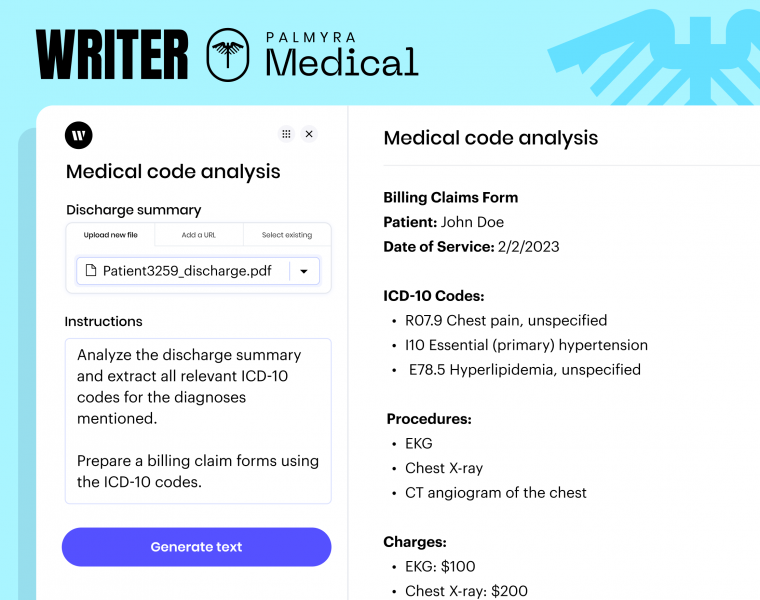 AI
AI
 AI
AI
 AI
AI
Enterprise-focused full-stack generative artificial intelligence platform Writer Inc. today announced the launch of two new specialized large language models specifically designed for the healthcare and financial services industries.
Beginning today, Writer is providing access to Palmyra-Med-70b and Palmyra-Fin-70b, specialized LLMs developed for medical and financial use cases respectively, on Nvidia Corp.’s NIM interference microservice, Baseten and Hugging Face, as well as Writer’s platform.
Palmyra-Med-70b is the latest iteration of the company’s medical AI model family and the company says that it benchmarks as the most accurate model available on the market. Testing has revealed it has an impressive accuracy of 85.9% across benchmarks for zero-shot attempts, surpassing the runner-up Med-PaLM-2 from Google LLC, which achieved 84% accuracy after six attempts.
Palmyra-Fin-70b, the financial fine-tuned counterpart to the medical AI model, is now the only financial model available as an Nvidia NIM inference microservice, the company said. It is capable of financial forecasting, investment analysis, risk evaluation, asset allocation strategy and other finance industry use cases.
Waseem Alshikh, co-founder and chief technology officer of Writer, told SiliconANGLE in an interview that one of the biggest challenges in building and fine-tuning specialized industry-specific models is domain expertise.
“You need to have experts telling you what type of data you need, how to deal with the data, how to categorize it and how to evaluate the models,” Alshikh explained. “So, we are lucky to have industry leaders working with us in healthcare and financial services full-time. Literally working inside the company, just help us actually categorize it.”

The results of this expertise mean that the models are highly capable, Alshikh said. In particular, Palmyra-Med stands out in one particular use case, which is medical legal review, a thorny subject even for humans. It requires comprehensive research across numerous source documents to produce highly accurate results. Equally important, healthcare is a highly regulated industry, so citations for sources, a low rate of errors, and trust in the model are paramount.
In a demo shown to SiliconANGLE, Palmyra-Med sifted through a press release for a cancer drug where it went sentence-by-sentence and evaluated the claims that a company made for the medication. For each claim, it made statements almost like a human in the comments section of a Wikipedia article including, “No sources for this claim, this is false” and “This is an off-label use.” It even rated the statistics in the press release by breaking them down with an analysis of their error values.
According to Writer, Palmyra-Med is used by Fortune 50 healthcare companies and healthcare firms Vizient Inc., CirrusMD Inc. and Medisolv Inc., to help improve patient outcomes with generative AI applications that use healthcare data and medical knowledge.

Palmyra-Fin displayed equal proficiency for assisting financial analysts when embedded in an application where it could provide summaries of Form 10-K statements. For example, if an analyst wanted to ask the model, “How does Apple Intelligence compare to Nvidia’s AI strategy?” the model would access the 10-Ks from both companies, which are exceptionally long documents, to produce a fairly in-depth description of the analysis of how the two different companies approach AI.
Both of these models are also available for developers to build with the Writer Framework, an open-source visual engine for building AI apps with low code, that makes it easy for technical to quickly build apps by making a user interface and hook them to an LLM.
Alshikh said Writer iterates on its models about every six months and plans to continue to upgrade them according to that cadence. The company also intends to roll out another domain-specific model but is still determining what domain it will encompass.
As for Palmyra-Med and Palmyra-Fin, Alshikh said, “We have a bigger plan to start pushing these models into multimodality. So the models will soon take images, video and audio as input and contain text as the output. Multimodality is coming soon to the models, for sure.”
Support our mission to keep content open and free by engaging with theCUBE community. Join theCUBE’s Alumni Trust Network, where technology leaders connect, share intelligence and create opportunities.
Founded by tech visionaries John Furrier and Dave Vellante, SiliconANGLE Media has built a dynamic ecosystem of industry-leading digital media brands that reach 15+ million elite tech professionals. Our new proprietary theCUBE AI Video Cloud is breaking ground in audience interaction, leveraging theCUBEai.com neural network to help technology companies make data-driven decisions and stay at the forefront of industry conversations.